
Toddy Tapper, 2013
Sap is tapped from the flower of the coconut palm tree in the fishermen village of Tranquebar. It is used for the production of palm wine. In Tamil the term kallu refers to freshly tapped, sweetish white sap.
Tranquebar – or Tharangampadi – is a village on the Coromandel Coast of south India. A large part of the population in Tranquebar are fishers or working within business related to fishing. The language is Tamil and the majority of the inhabitants adhere to religious traditions of Hinduism, but there are also smaller communities relating to Christianity or Islam.
During India’s colonial period, Tranquebar functioned as a Danish trade station from 1620-1845. The place has a rich intercultural history, documented in historical buildings and rich archival sources as well as old and new ethnographic collections of material items, photos and accounts of everyday life.